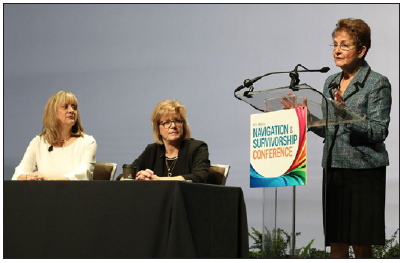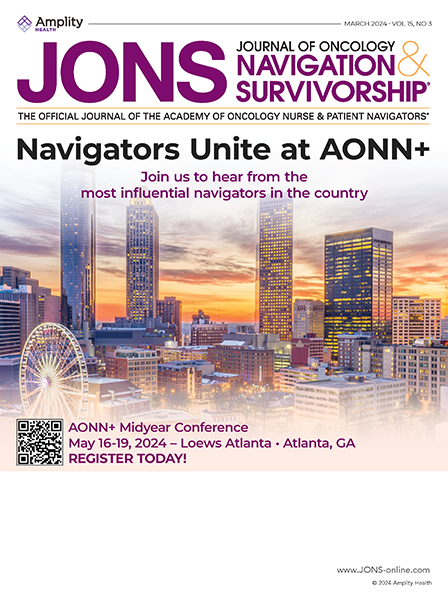
Tricia Strusowski, RN, MS, and Elaine Sein, BSN, RN.
About 2 years ago, the Academy of Oncology Nurse & Patient Navigators (AONN+) unveiled 35 evidence-based oncology navigation metrics. The impetus for this endeavor came from the recognition of a void in the literature measuring the programmatic success of navigation programs. These baseline metrics measure patient experience, clinical outcomes, and return on investment and are vital to coordinating high-quality, team-based care and demonstrating the sustainability of navigation programs. In addition, they are applicable to any institution, irrespective of the structure of their navigation program.
Now, a recently launched pilot study entitled, “National Evidence-Based Oncology Navigation Metrics: Multisite Exploratory Study to Demonstrate Value and Sustainability of Navigation Programs,” or NAVmetrics, for short, is beginning to shed light on the accessibility of the metrics once they are actually put into practice in oncology navigation programs across the United States.
At the AONN+ 9th Annual Navigation & Survivorship Conference, members of the AONN+ Standardized Metrics Task Force, including Danelle Johnston, MSN, RN, ONN-CG, OCN, Senior Director of Strategic Planning and Initiatives at The Lynx Group/AONN+; Elaine Sein, BSN, RN, an independent navigation consultant; and Tricia Strusowski, RN, MS, Manager of Chartis Oncology Solutions, discussed the importance of these metrics in oncology navigation and shared preliminary progress from the navigation metrics pilot study, which was designed in collaboration with the American Cancer Society (ACS) and Chartis Oncology Solutions.
The Navigator’s Professional Responsibility
According to Ms Johnston, it is imperative that oncology clinical navigators and nonlicensed patient navigators understand that active participation in data collection, analytics, and reporting outcomes are not added responsibilities but are already a part of their professional role.
“Value-based care is embedded in outcome metrics,” she said. “We can’t run from it; it’s here. In the landscape of value-based care, you need to be involved with your administrators in data collection, reporting, and being able to speak to your program.”
“You don’t collect metrics for the sake of collecting metrics, you need to do something with that data,” she added. Once data have been collected, evaluate whether the process under examination is going well or if there are areas in need of improvement; if there are, implement a performance improvement strategy and continue to measure that outcome and demonstrate and report any improvements, she advised.
According to Ms Johnston, as patients move through the continuum, navigators are in a unique position to identify gaps in process issues in the health system. They can use that opportunity to capture measurements that demonstrate those issues, then put them in front of administrators and physician teams and identify ways to improve those processes and impact patient care and outcomes.
“We’ve known for a long time that we can anecdotally speak to our value, but now we have to demonstrate it. I feel that the navigator has a unique view and perspective, and I call this the ‘30,000-ft view,’” she said. “Use your role and the advantage of that view to make a difference.”
The Impact of the Triple Aim
The landscape of healthcare has shifted, largely due to the Triple Aim of healthcare that aims to improve the patient experience of care, improve the health of populations, and reduce the per capita costs of medical care. As a result, national standards to adhere with value- based care are now propelling cancer programs to be accountable to measure both the quality of care delivery and its cost. That’s where metrics come in.
Historically, navigation programs have reported a knowledge deficit related to quality studies and performance improvement methodologies regarding how to measure and demonstrate program value and sustainability. According to the AONN+ clinical study team, improving standardization of patient metrics would allow clinicians, policy makers, patients, and other researchers to better measure the impact of patient navigation across the continuum of cancer care.
But a comparison between outcomes is not relevant if there is no standardized data element. “That’s what we’re trying to achieve with our national study,” she said. “We will have data definitions and a numerator and denominator defined. We all have to be working from the same framework if we’re going to create benchmarking and be able to compare that data from one program to another.”
According to Ms Johnston, there is a lot of work to be done, but passionate people are helping to drive this initiative, including the Biden Cancer Initiative’s Patient Navigation Working Group and the ACS National Navigation Roundtable. “They’re both very excited to see the outcomes of our national study and to see how it can help drive navigation,” she said.
The NAVmetrics Study
NAVmetrics went live on November 1, 2018, at 8 pilot sites. The primary objectives of the 6-month study include implementation and validation of metrics, establishing national evidence-based standardized navigation benchmarks, conducting navigation research to validate sustainability and value of navigation, identification of navigation outcome measurement and best practices and lessons learned, and the creation of a centralized navigation metrics database and repository powered by business intelligence.
The study sites are capturing and reporting data from 10 of the AONN+ standardized metrics. These 10 study metrics were chosen from the domains of Care Coordination/Care Transition; Operations Management, Organizational Development, Health Economics; Psychosocial Support, Assessment; Survivorship and End of Life; Patient Empowerment/Patient Advocacy; Professional Roles and Responsibilities; and Research, Quality, Performance Improvement. Through qualitative data collection, they will identify clinical and IT challenges and barriers with navigation metrics implementation, as well as common barriers and challenges (both individual and system-level) to metrics measurement, and strategies for overcoming them.
Ms Strusowski provided case studies from participating study sites that are already beginning to see the value of data collection. The University of Arizona Cancer Center began collecting data at the beginning of 2017, and they were able to identify their top 2 barriers to care that year: history of anxiety, depression, or a mental health diagnosis; and distress. In the first 2 quarters of 2018, their leading barrier to care remained the same, but activities of daily living replaced distress as number 2. Observing and determining the reasons behind these types of barriers, as well as potential solutions, are among the study’s main goals.
“Hopefully, we will now have some foundation benchmarks that compare apples to apples, because we’re going to be using the same discrete data elements for each of the metrics that we’re capturing,” said Ms Sein, adding that preliminary results should be unveiled at the AONN+ Midyear Conference, May 17-19, 2019, in San Diego, with final results set to be presented at the next annual conference in Nashville.
“To get what we’ve never had, we must do what we’ve never done,” added Ms Johnston. “I want to empower each one of you in your professional practice to take these metrics and implement them in your setting to demonstrate the value and the impact that each of you make on patient care and outcomes.”



